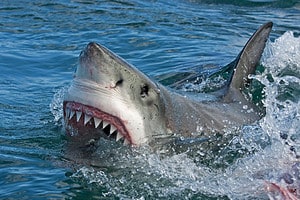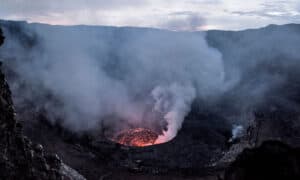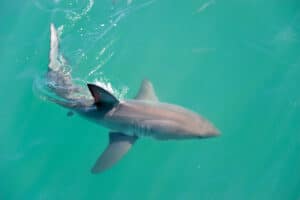Mako sharks — these underwater marvels are nature’s true speedsters. With their streamlined bodies, incredible agility, and a set of razor-sharp teeth, they’ve earned their rightful place as one of the most captivating species in the marine world. From their unique biology to their intriguing behavior, mako sharks have fascinated researchers and ocean enthusiasts alike.
Despite their widespread distribution, each population holds unique stories, and the mako sharks found in the waters off the coast of Maine are no exception. Maine, known for its picturesque coastlines and rich marine life, offers a unique backdrop to unravel the mysteries of these extraordinary creatures.
In this exploration, we discover the largest mako shark ever caught in Maine. We delve deeper into the lives of Maine’s mako sharks, understanding their diet, their predators, and their intriguing interaction with humans.
Get ready for a deep dive into the captivating world of mako sharks in Maine.
The Largest Mako Shark Ever Caught in Maine
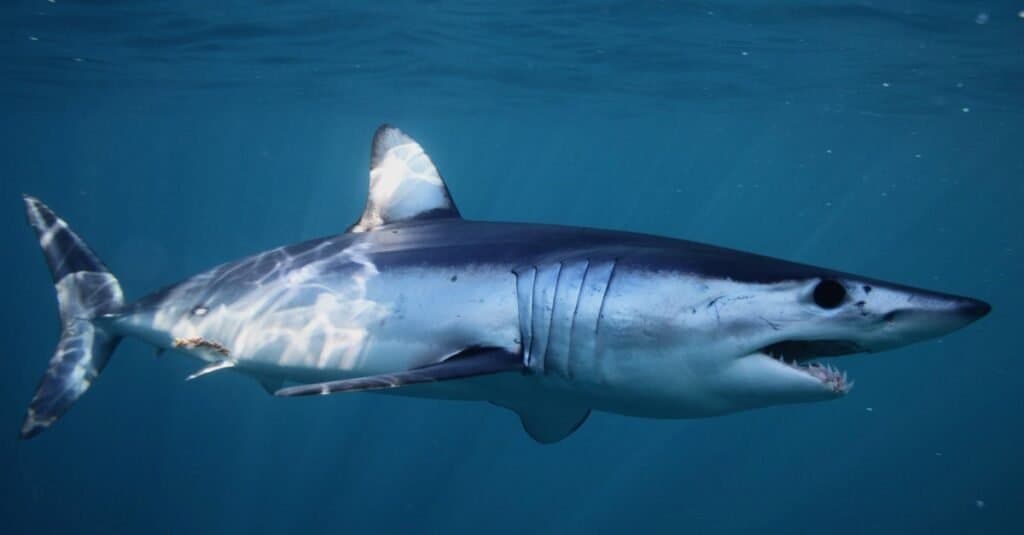
Shortfin mako sharks grow slowly and can grow up to 12 feet, although the average size is 6 to 7 feet.
©iStock.com/Alessandro De Maddalena
The largest mako shark ever caught in Maine weighed 724 lbs. Angler Mark Chase caught the fish through handline fishing at Portland on August 15, 1992.
The Largest Mako Shark Ever Caught in the World
According to The International Game Fish Association, the largest mako shark on record was caught in 2001. A fisher off the coast of Chatham, Massachusetts, successfully reeled in this behemoth using a 130-lb line. The female shark tipped the scales at 1,221 pounds and likely stretched over 11 feet in length.
Yet, this massive mako from Massachusetts isn’t the only large mako shark hauled in off the coast of the United States. Another giant mako exists that, due to bureaucratic hurdles, doesn’t feature in the IGFA’s world record list.
Back in 2013, a mako shark that was even larger than the officially recorded biggest mako met its end at the hands of a fisherman in California. This Californian mako tipped the scales at an astounding 1,323 pounds and stretched over 11 feet. By weight, this could very well be the heaviest mako shark ever documented. However, the official IGFA record remains untouched because there’s a possibility that the fisher had assistance reeling in this colossal catch. Despite this technicality, the legend of this massive mako continues to make waves.
Biological Overview of Mako Sharks
Let’s dive into the exciting world of mako sharks. These magnificent creatures, truly one of nature’s marvels, are swimming in mysteries we’re just beginning to uncover.
The Family Tree: Classification and Taxonomy
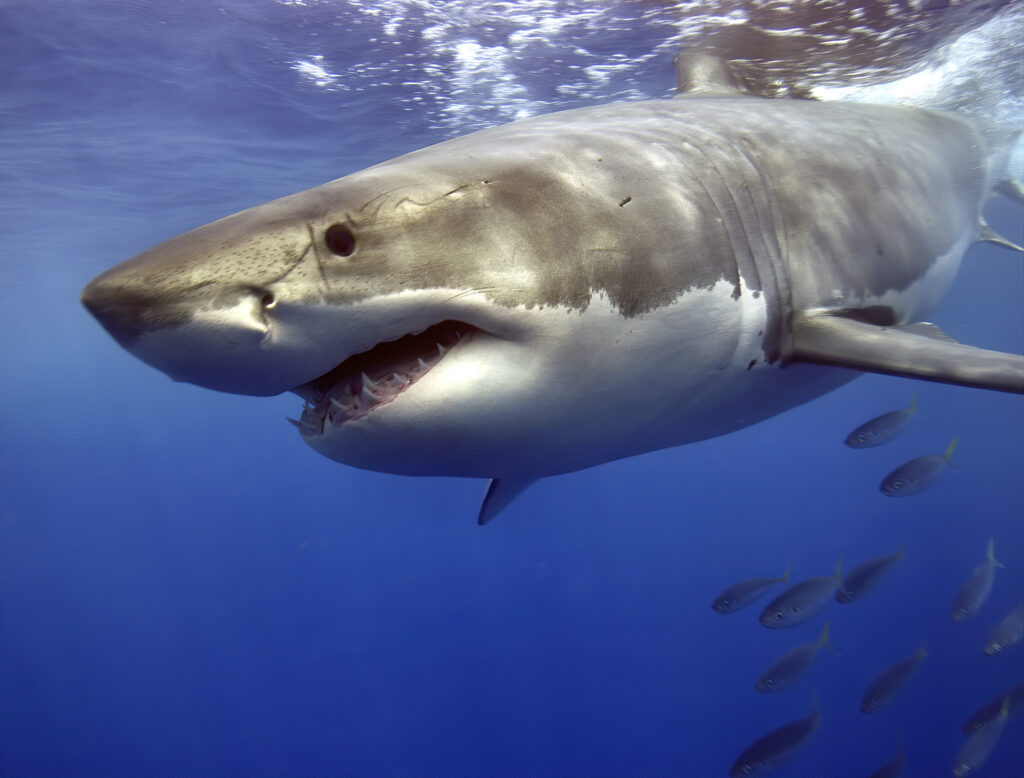
Great white sharks are in the same family as mako sharks.
©iStock.com/Martin Heyn
Mako sharks belong to the family Lamnidae, famously known as the mackerel sharks. They share this family with some big names, including the great white shark. Scientifically, we call the mako shark ‘Isurus’, which translates to ‘equal tail’ in Greek. This makes sense because they have a lunate tail with almost equal upper and lower lobes.
There are two main types we see — the shortfin mako shark and the longfin mako shark. The shortfin variety is more common and is usually the one you’ll find around Maine.
Physical Characteristics
Mako sharks are not just ordinary sea creatures. They’re incredibly adapted to oceanic life. Sporting a streamlined, torpedo-shaped body, they cut through water like a hot knife through butter. The most striking thing about them? Their deep blue color on top and a lighter white underside. This coloration is not just for show; it helps them camouflage in the deep waters – a neat trick called counter-shading.
Size-wise, they’re no slouch. The Shortfin mako usually grows up to 10 feet, but some individuals reach a whopping 12 feet! They’re heavyweights, too, tipping the scales at around 1200-1350 pounds. And those teeth! Their razor-sharp, curved teeth protrude from the mouth, giving them a ferocious yet captivating look.
Time and Growth: Lifespan and Growth Rate
Mako sharks have a long lifespan and are known to live up to around 30 years. They start small as pups, around two feet long, and grow slowly. Each year they add about a foot to their length until they reach adulthood. The average-sized Mako is about 6 to 8 feet long, depending on whether it’s a shortfin or longfin. Some species have been known to reach 14 feet.
What Do Mako Sharks Eat?
Let’s dive deeper into the thrilling dining preferences of mako sharks. We’re about to embark on an oceanic culinary journey that intertwines survival instinct, hunting prowess, and ecological balance. So tighten your scuba gear, and let’s go!
Hunting and Feeding: An Art Mastered
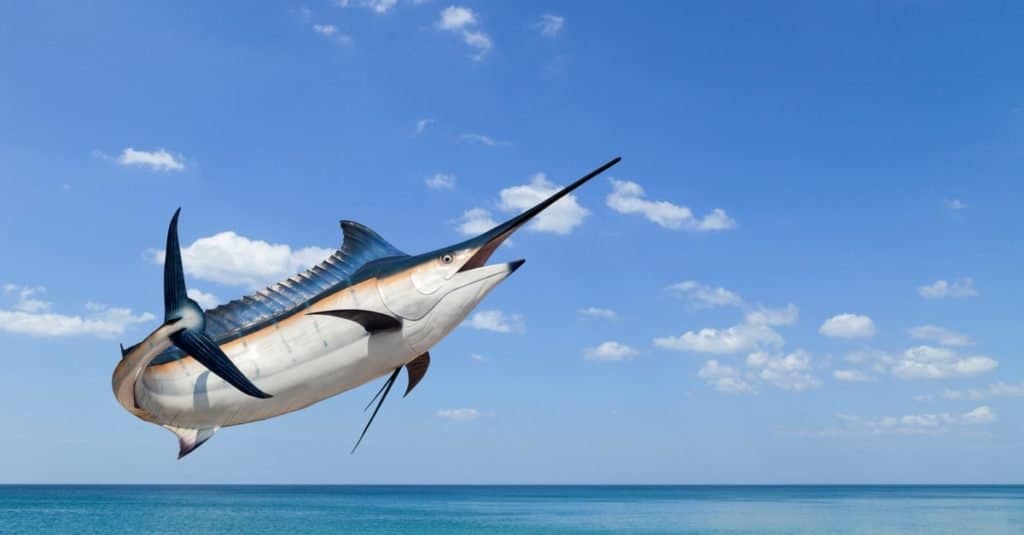
Mako sharks have been known to hunt swordfish.
©Stock High angle view/Shutterstock.com
When it comes to hunting, mako sharks are maestros of the sea. Their streamlined bodies enable explosive speed, with bursts up to 31 miles per hour. This makes them one of the fastest fish in the sea. And don’t forget about their razor-sharp teeth—they’re perfect for sinking into slippery, fast-moving prey like mackerel, tuna, and swordfish. The makos also have a knack for squid, the more elusive delicacy of the deep. On occasion, they may sample other species too—sea turtles, seabirds, and even smaller sharks can be part of their diverse palate.
The secret to their hunting success? They employ a hit-and-run technique—they strike their prey at high speed, stunning or killing it instantly. Then, they loop back to devour their meal. It’s an awe-inspiring display of power and precision.
The Culinary Navigator: Food-driven Migration
The dining habits of mako sharks play a significant role in their migration patterns. Food is their compass, guiding them through vast ocean expanses. They’re especially fond of following tuna, a frequent item on their menu, on their migratory journeys. If you ever find a mako shark in the waters of Maine, you can almost bet there’s a delicious congregation of fish nearby. They have an extraordinary ability to sense prey from miles away, thanks to their sharp olfactory senses and lateral line system that detects movements in the water.
The Ecological Chef: Maintaining Marine Balance
Deep down, mako sharks are like ecological chefs, mixing and stirring the marine ecosystem ingredients just right. Their diverse diet and predatory nature keep many marine populations in check. Overpopulated prey species can cause imbalances in the food chain, leading to unhealthy ecosystems. By preying on various species, makos ensure no single species dominates others, promoting biodiversity and a healthy ocean environment.
Their hunting also helps in the survival of the fittest. They often target weak, injured, or sick individuals, thus promoting stronger genetic lines in the prey species. In essence, they’re helping to stir the pot of genetic diversity, ensuring the overall health and robustness of marine life.
Predators of Mako Sharks: The Deep Dive
Now that we’ve skimmed the surface, it’s time to plunge deeper into the predatory dangers that mako sharks face. It’s an intricate web of natural law and human interference, and it’s essential to the survival of these incredible creatures. Take a deep breath, and let’s dive in.
Natural Predators in the Wild
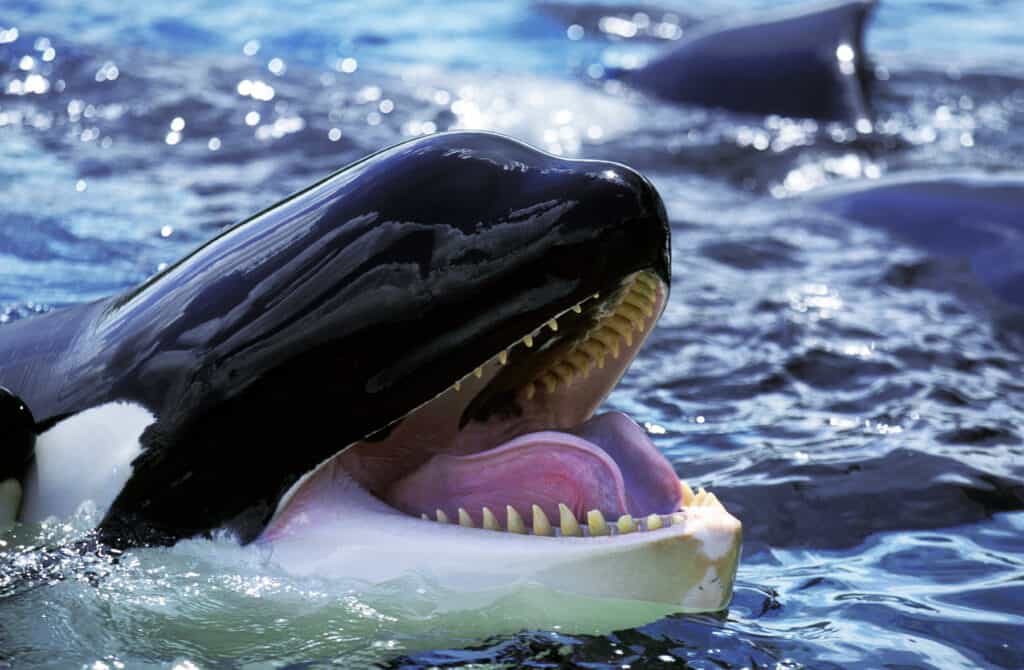
Orcas look cute, but they can be vicious hunters of mako sharks.
©slowmotiongli/Shutterstock.com
Makos, despite being impressive predators themselves, aren’t at the top of the ocean’s food chain. Large shark species, such as the formidable great white shark, don’t hesitate to seize an opportunity to prey on makos. It’s an impressive spectacle of marine power play, showcasing the brutal yet fascinating laws of survival in the ocean.
Then we have the killer whales, or orcas, another formidable predator. Known for their intelligence, strength, and coordinated hunting techniques, orcas are one of the few creatures that dare to take on mako sharks. These powerful mammals employ complex strategies to overpower their prey, demonstrating the intricate dynamics of predator-prey relationships in the ocean.
Remember, these natural predators usually target young, sick, or injured makos. Adult makos, in their prime, face few threats in their natural habitat.
Human Predation: An Unnatural Threat
Humans pose the greatest danger to mako sharks. Commercial and recreational fishing often target makos for their meat and fins. Their meat is a popular choice in seafood dishes, and their fins, sadly, are used in the contentious shark fin soup.
But there’s more. Makos, being curious creatures, often fall victim to bycatch. This term refers to unintentional capture during commercial fishing operations. Makos attracted to the bait get caught in fishing nets and lines, often resulting in serious injury or even death.
The Impact of Predation
Predation has a profound impact on the health and dynamics of marine ecosystems. In the natural world, predation helps control the population of species and maintains a balanced ecosystem. For example, when orcas or larger sharks prey on makos, they indirectly influence the populations of species that makos feed on, shaping the ecosystem’s overall structure.
However, human predation skews this natural balance. Overfishing and bycatch are leading to a rapid decline in mako shark populations worldwide. This decline is a serious concern because, as apex predators, makos play a pivotal role in maintaining marine biodiversity. Their absence can lead to a domino effect, disrupting the balance and health of our oceans.
Mako Shark Sightings in Maine
It’s time to zoom in on mako sharks in Maine. These elusive visitors aren’t everyday sights, so when you spot one, it’s quite the spectacle. Let’s dive into the nitty-gritty of mako shark sightings in the beautiful waters off the coast of Maine.
Rare Visitors: Frequency of Sightings
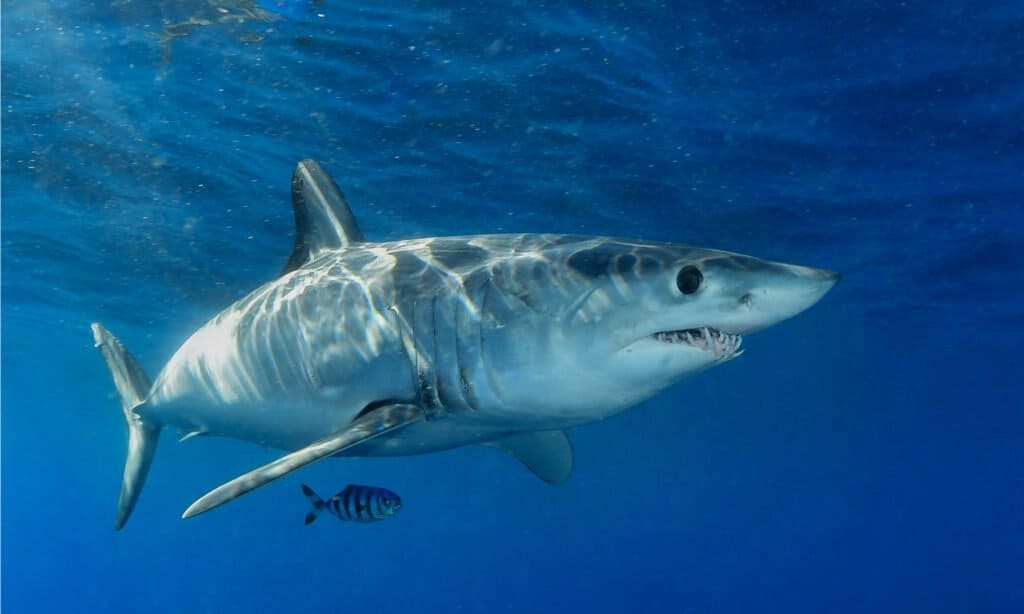
Shortfin mako shark swimming with pilot fish. Pilot fish are small fishes that can be seen swimming alongside sharks and other bigger fishes.
©Xavier ELIAS Photography/Shutterstock.com
Spotting a mako shark in Maine is not a regular occurrence. These speedsters of the sea tend to hang out in deeper, offshore waters and only occasionally venture close to the coast. If you ever do see one, consider yourself part of an exclusive club!
Summer Travelers: Seasonal Patterns
Makos, being the seasoned travelers they are, follow the warmth. As the waters of Maine warm up in the summer, mako sharks journey northward from their usual haunts in search of food. The peak months for potential mako sightings in Maine are typically from June to August. Summer is your best bet to catch a glimpse of these magnificent creatures.
Signs of a Visit: Traces of Makos
Not all mako shark visits are visible to the naked eye. Sometimes, they leave subtle signs behind. For example, anglers may find tell-tale bite marks on their catch, a sure sign of a mako’s razor-sharp teeth. Occasionally, makos may be spotted breaching the surface, a spectacular display of their power and agility. Keep an eye out for these signs; they’re clues to a mako’s presence!
Documented Sightings: The Mako-Encounter Chronicles
There have been a handful of recorded mako shark sightings in Maine over the years. These instances, documented by local fishermen and marine biologists, provide valuable data on makos’ migratory patterns and behavior. Each sighting is a piece of the puzzle, helping us better understand these mysterious and fascinating creatures.
Interaction between Mako Sharks and Humans
Are you ready to explore the often-complicated relationship between mako sharks and humans? From thrilling encounters to concerning conflicts, our interactions with these sea-dwelling marvels are rich in detail and complexity.
Thrill-Seekers’ Delight: Recreational Encounters
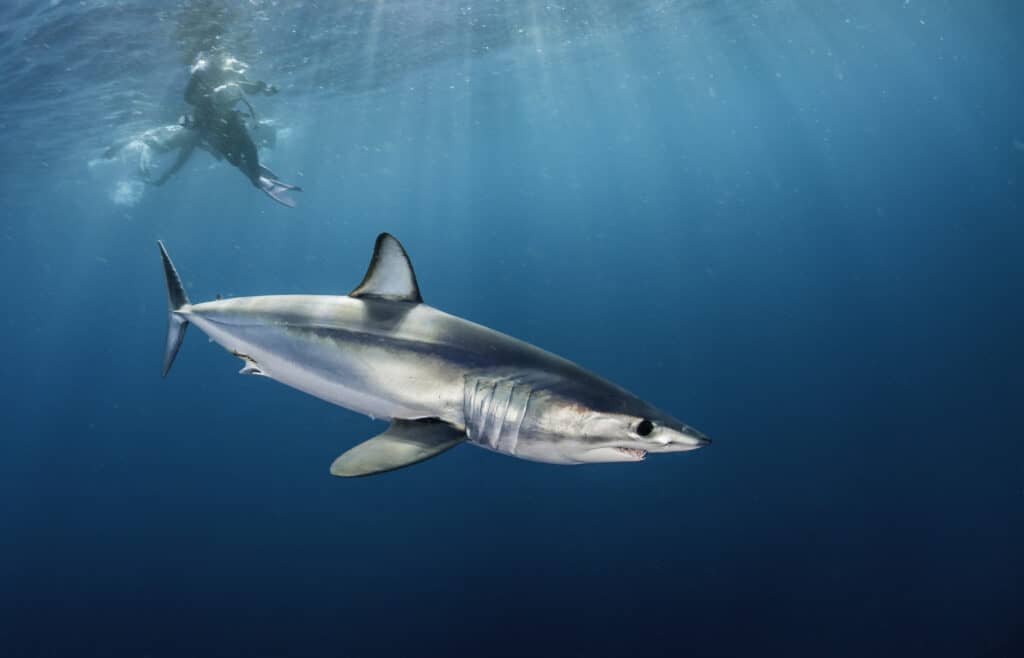
A diver swimming with a Shortfin mako shark. These sharks are aggressive predators and should be avoided if possible.
©wildestanimal/Shutterstock.com
Let’s start on a high note. Mako sharks are a dream come true for sport fishermen. Why, you ask? Well, their speed, strength, and agility make them a challenging yet rewarding catch. In addition, the adrenaline rush of hooking a mako is a lure for many fishing enthusiasts.
But it’s not just fishing. Some brave divers seek out controlled encounters with makos, drawn by their raw power and captivating presence. Though it’s important to remember, these interactions should always prioritize the safety of both the sharks and humans.
The Culinary Connection: Commercial Fishing
Now, let’s address the elephant in the room—commercial fishing. Mako sharks, sadly, are a common target for their meat and fins. Their flesh is considered tasty, and their fins often find their way into shark fin soup—a dish that’s sparked a great deal of controversy due to its environmental impact.
Moreover, makos often become victims of bycatch. In their curious pursuit of bait, they get entangled in nets meant for other species, leading to injury and often death.
Unintended Consequences: Shark Attacks
While mako shark attacks on humans are rare, they do happen. Most of these instances involve provoked attacks, like during fishing when a hooked mako defends itself. Unprovoked attacks are incredibly rare, given that humans aren’t on the mako’s menu.
Conservation: The Human Role
Humans play a significant role in the future of mako sharks. Therefore, awareness and regulation are key. Many organizations are working tirelessly to regulate fishing, protect shark habitats, and raise public awareness about the vital role of sharks in marine ecosystems.
Public sentiment towards sharks is slowly shifting, moving from fear and misunderstanding to respect and appreciation. By promoting sustainable fishing, supporting shark conservation initiatives, and spreading awareness, we can ensure a safer future for mako sharks.
Key Takeaways
We’ve journeyed through the thrilling world of mako sharks, exploring their lives right off the coast of Maine. Also, we’ve discovered their incredible speed and dug into their varied diet.
We’ve also navigated the challenges they face, from overfishing to climate change, and how these threats impact their survival. But remember, understanding and protecting mako sharks isn’t just about these fascinating creatures alone. It’s about preserving the health and diversity of our oceans—a cause that impacts all of us.
The photo featured at the top of this post is © iStock.com/Jtafalla
Thank you for reading! Have some feedback for us? Contact the AZ Animals editorial team.



